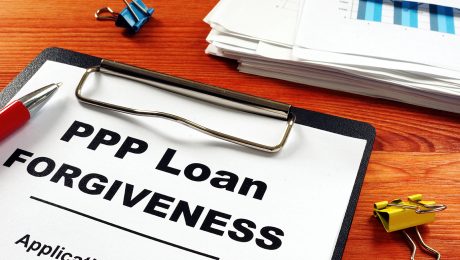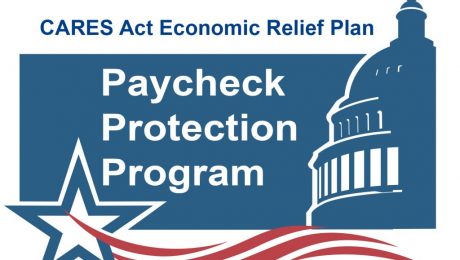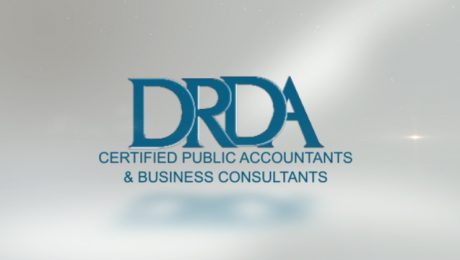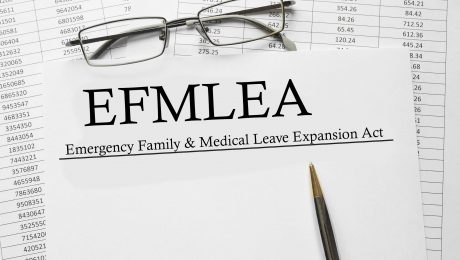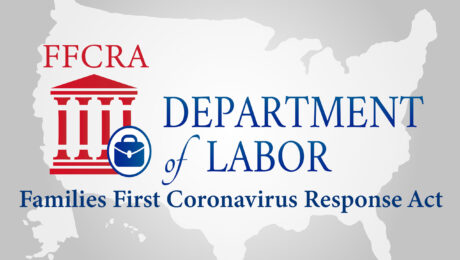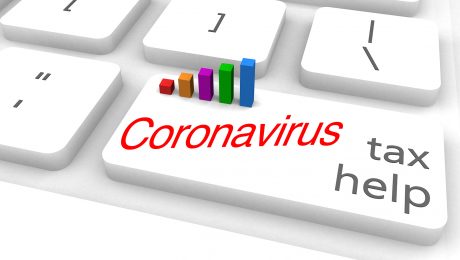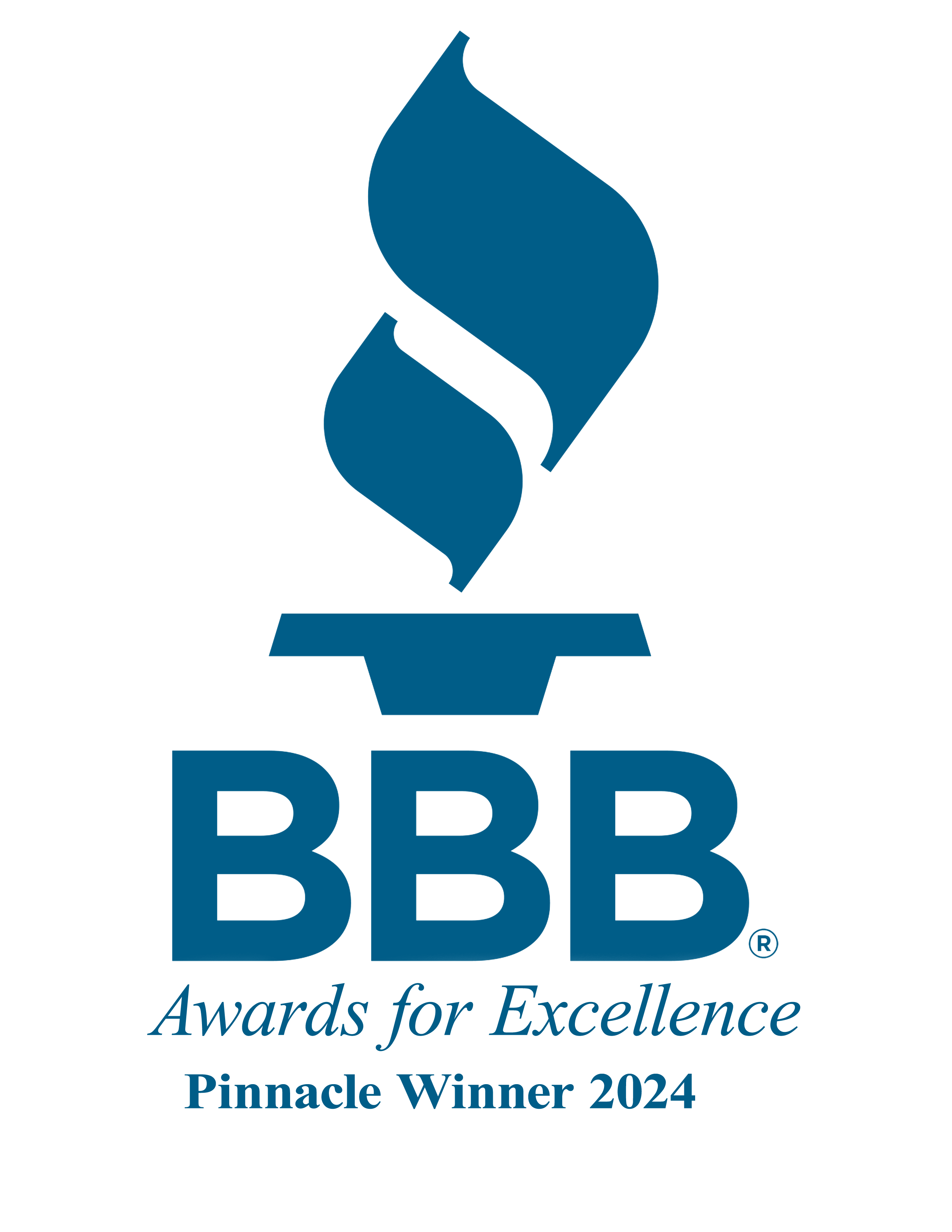Paycheck Protection Program Loan Forgiveness
Small Businesses who received Paycheck Protection Program loans can prepare for the process of having the debt reduced or even wiped clean with the forgiveness application released by the Small Business Administration on Friday May 15,2020.
SBA said it planned to release official regulations and guidance soon. But the form might help employers by offering reminders of the rules as well as what appears to be some new guidance on how the government will handle loan forgiveness.
According to a SBA news release Friday:
The form and instructions include several measures to reduce compliance burdens and simplify the process for borrowers, including:
• Options for borrowers to calculate payroll costs using an “alternative payroll covered period” that aligns with borrowers’ regular payroll cycles
• Flexibility to include eligible payroll and non-payroll expenses paid or incurred during the eight-week period after receiving their PPP loan
• Step-by-step instructions on how to perform the calculations required by the CARES Act to confirm eligibility for loan forgiveness
• Borrower-friendly implementation of statutory exemptions from loan forgiveness reduction based on rehiring by June 30
• Addition of a new exemption from the loan forgiveness reduction for borrowers who have made a good-faith, written offer to rehire workers that was declined (Minor formatting edits.)
“The Treasury Department and Small Business Administration released a loan forgiveness application form for the CARES Act’s Paycheck Protection Program (PPP), which had been urgently sought by CPA firms and their small business clients in recent weeks,” the American Institute of CPAs wrote in a news release Saturday. “The document and related instructions partially address some outstanding issues but leave others unaddressed and, more importantly, still do not provide enough flexibility for those who receive funds, according to the American Institute of CPAs. Download the PPP Forgiveness Loan calculator from the American Institute of CPAs.
The SBA opened the PPP process on April 3. Small Businesses who managed to obtain the PPP loans in the early days of eligibility are coming up on the eight-week (current to 6-7 weeks in) “Covered Period” to have spent the money, which means some might want to get the ball rolling on the forgiveness process for peace of mind. (The deadline to apply for forgiveness is unclear, but the form carries an Oct. 31 expiration date.) Otherwise, the loans carry 1 percent interest and mature in two years.
The eight-week “Covered Period” starts ticking either on the day you received loan dollars, but the feds say they’ll also allow employers to key off of their first pay period after receiving the loan — within limitations. For example, the 25 percent of the loan which can be spent on eligible non-payroll costs like rent must have been spent during the “Covered Period.”
“For administrative convenience, Borrowers with a biweekly (or more frequent) payroll schedule may elect to calculate eligible payroll costs using the eight-week (56-day) period that begins on the first day of their first pay period following their PPP Loan Disbursement Date (the ‘Alternative Payroll Covered Period’). For example, if the Borrower received its PPP loan proceeds on Monday, April 20, and the first day of its first pay period following its PPP loan disbursement is Sunday, April 26, the first day of the Alternative Payroll Covered Period is April 26 and the last day of the Alternative Payroll Covered Period is Saturday, June 20,” the form states. “Borrowers who elect to use the Alternative Payroll Covered Period must apply the Alternative Payroll Covered Period wherever there is a reference in this application to ‘the Covered Period or the Alternative Payroll Covered Period.’ However, Borrowers must apply the Covered Period (not the Alternative Payroll Covered Period) wherever there is a reference in this application to ‘the Covered Period’ only.”
The government will also accept the spending if costs are incurred during the time frame and paid by the first payday or billing date after it.
“Borrowers are generally eligible for forgiveness for the payroll costs paid and payroll costs incurred during the eight-week (56-day) Covered Period (or Alternative Payroll Covered Period) (‘payroll costs’),” the form states. “Payroll costs are considered paid on the day that paychecks are distributed, or the Borrower originates an ACH credit transaction. Payroll costs are considered incurred on the day that the employee’s pay is earned. Payroll costs incurred but not paid during the Borrower’s last pay period of the Covered Period (or Alternative Payroll Covered Period) are eligible for forgiveness if paid on or before the next regular payroll date. Otherwise, payroll costs must be paid during the Covered Period (or Alternative Payroll Covered Period). …
“An eligible nonpayroll cost must be paid during the Covered Period or incurred during the Covered Period and paid on or before the next regular billing date, even if the billing date is after the Covered Period. Eligible nonpayroll costs cannot exceed 25% of the total forgiveness amount. Count nonpayroll costs that were both paid and incurred only once.”
The government will forgive the loan and any interest if at least 75 percent of the money received had been spent on payroll and the remainder spent on rent, utilities or mortgage interest, according to the form. The maximum forgivable amount per employee maxes out at what would work out to $100,000 a year in pay.
The amount forgiven will be decreased proportional to the drop-in workforce and potentially pay. The government will let pay cuts slide if employees made at least 75 percent of what they averaged between Jan. 1 and March 31 or were paid between Feb. 15-April 26, the average salary or hourly wage they were making as of Feb. 15, according to the new form. Borrowers that cut pay more than the government would like can receive a pass if they restore paychecks to Feb. 15 levels by June 30.
The government also will let layoffs slide and forgive the full loan if you laid off people between Feb. 15-April 26 and brought your workforce to Feb. 15 levels by June 30, according to the form. It also grants an exemption to an employer who fired employees for cause or “made a good-faith, written offer” to rehire a worker only to have the employee decline. Exemptions also exist if the employee quit voluntarily or asked for their hours to be reduced. “Any FTE reductions in these cases do not reduce the Borrower’s loan forgiveness,” the form states.
Congress appropriated hundreds of billions for PPP small business loans over the course of two separate bills, resulting in a PPP “Phase One” and “Phase Two.” The forgivable loans were seen as a means of helping small businesses preserve jobs after the national COVID-19 coronavirus response shattered the economy.
PPP “Phase One” saw another more than $342 billion net dispensed in nearly 1.7 million loans made by 4,975 lenders, according to the SBA. The average “Phase One” loan came out to $206,000. Nearly 26,000 loans exceeding $2 million had been issued in Phase One; these represented 1.57 percent of the loan applications approved, but nearly 28 percent of the loan dollars.
After the PPP program ran out of money (lawmakers approved $349 billion), Congress approved more funds for what became “Phase Two.” Generally speaking, you can borrow the equivalent of 10 weeks of payroll.
As of 5 p.m. Saturday May 16,2020, 5,479 “Phase Two” lenders had issued nearly $195.2 billion across nearly 2.8 million loans. The average “Phase Two” loan worked out to $70,622.
More information:
PPP loan forgiveness application and instructions
Small Business Administration, May 15, 2020
“AICPA Says Treasury and SBA PPP Loan Forgiveness Application Leaves Many Questions”
American Institute of CPAs, May 16, 2020
SBA “Coronavirus Relief Options” page
SBA Paycheck Protection Program (PPP) webpage
List of PPP lenders in your state
Paycheck Protection Program FAQs
SBA, May 13, 2020
- Published in Business Lending, Small Business
Payroll Protection Program (PPP) to relaunch Monday April 27, 2020
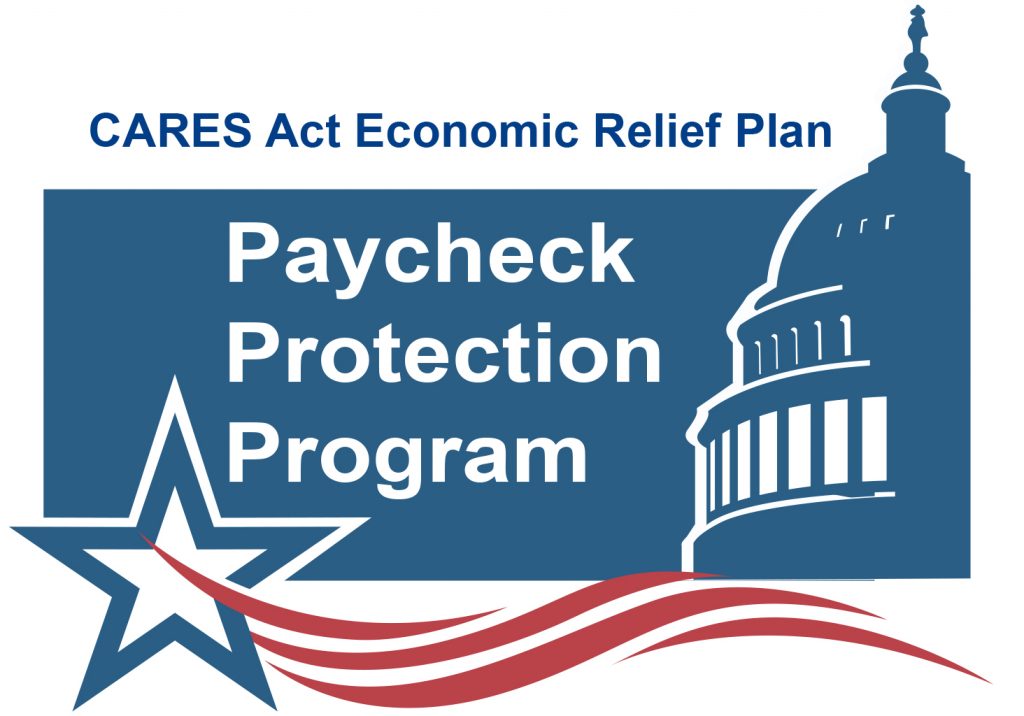
DRDA continues to provide you information as quickly as we can related to any tax law changes, as well as financial aid and loan opportunities as a result of the COVID-19 crisis. As you can imagine, this is a rapidly changing environment and we will continue to disseminate information as it is made available to us.
On March 27th 2020, President Trump enacted the Coronavirus Aid, Relief, and Economic Security (CARES) Act to Help small businesses keep workers employed through a program known as the Paycheck Protection Program (PPP). Which allowed banks to issue SBA 100% federally guaranteed loans to small businesses that can attest to suffering economic hardship as a result of the COVID-19 crisis. Importantly, these PPP loans may be forgiven if borrowers maintain their payrolls during the crisis or restore their payroll afterward.
Yesterday April 23, 2020 Congress approved an additional $310 billion in Funding to replenish the PPP Program which has run out of money. Congress had allotted an initial $349 billion in the last relief bill, a $2.2 trillion package enacted on March 27, only to see the funds run dry shortly afterward due to the rush of businesses seeking to tap the benefits.
Banks will start processing application Monday April 27, 2020. We anticipate the money to move very quickly. We suggest to those applying for the PPP, to do so as soon as possible, and be ready to submit their applications immediately as the program becomes available.
Here is a link to a small business guide published yesterday by the U.S Chamber of Commerce. Please take the time to read this memo, and if you believe your business qualifies (if you need help in that determination, please let us know), then you need to contact your banker to start the process. Please keep in mind, these loans are moving very fast and they are being created as a “first come, first served” priority list for applicants. This will typically be a bank process, not an accounting process, so submitting a loan application through your bank will be of the utmost importance.
The last twelve (12) months payroll information will be needed. It is our understanding at this time, that payroll will include wages, employer paid payroll taxes, health insurance premiums and retirement expense (i.e. 401(k) match).
As stated previously, for the PPP loan to be forgiven your business will have to prove that it retained and continued to pay employees. The rules are still evolving regarding the employee retention provision but understand that employee retention is paramount to having this loan forgiven.
The administration’s PPP program guidelines can be found at www.treasury.gov, and the U.S. Small Business Administration’s search tool to find a bank that offers PPP loans can be found at www.sba.gov/paycheckprotection/find.
We hope that you are well, and please stay safe. Please don’t hesitate to contact us with any questions you may have.
- Published in Business Lending, Small Business, Tax
DRDA – Jennifer Lopez spotlight in UHCL “The Signal”

DRDA’s own Jennifer Lopez, Human Resources and Learning Development Coordinator was spotlighted this week in the University of Houston – Clear Lake news publication “The Signal.”
The article covers her educational path as a student and parent, and now with a full-time career. “I think the most important thing I learned,” said Jennifer, “is how to take a curriculum outside of my classroom and into a board room or training room. Just because its education doesn’t mean it has to be in a K-12 classroom. It can be corporate or anywhere.” She continues to add, “What I learned in my undergraduate classes at UHCL is to be a better instructor across the board, whether it’s a child or an accountant.”
“Her skill sets were amazing,” said Dr. Jana Willis, Professor of Instructional Design and Technology, “she had worked very hard to get to where she was in her educational journey. Her journey took her from NASA aerospace scholar, to computer engineering, to mathematics major, to a master’s degree in instructional technology, and now to a doctorate in curriculum and instruction. It’s all adding to the brilliance I saw in that undergraduate classroom. Jennifer is a role model for all UHCL students.”
Jennifer will be Graduating this May, receiving her Master’s degree in Instructional Technology and Design with a specialization in Human Resources.
- Published in Uncategorized
Your BORSA Plan and the CARES Act

On March 27, 2020, the Coronavirus Aid, Relief, and Economic Security (CARES) Act was enacted to address the
financial difficulties that have resulted from the COVID‐19 pandemic. Included in this law were provisions that
provide special coronavirus related distributions (CRD) for qualifying plan participants. Below is a brief summary of the new CRDs available and new loan provisions to qualifying participants.
Coronavirus Related Distribution:
Qualifying participants can request a distribution of up to $100,000 from the retirement plan without incurring a
10% early distribution penalty. There is no age requirement and you can take coronavirus‐related distributions
whether actively employed or not. You can request the entire amount in a one lump sum, or multiple payments, but all must be taken by no later than December 30, 2020.
There is a federal tax withholding requirement of 10%, but you may choose to waive it completely or withhold a
different amount at the time of distribution. The amount of distribution is subject to federal tax, but you will be able to spread the taxes owed on the distribution over three years.
You may repay the entire amount distributed to you within three years. This opportunity allows you to repay
some or all of the distribution to any qualified plan or IRA that accepts rollovers as a way to minimize your income
tax liability. This is different than a loan in that there is no interest and no periodic payment requirement, and the
ability to repay does not require an election at the time of distribution. Repayment can be in a single lump sum or
via installments of different amounts at different times, but the repayment window only runs for three years from
the date you first receive the distribution.
It is important to emphasize that this new CRDs only apply to individual plan participants that meet certain requirements. If you should choose to utilize either of these provisions, you must certify that you meet one or more of the conditions listed below.
You have experienced adverse financial consequences as a result of:
• having been diagnosed with SARS‐CoV‐2 or COVID‐19 by a test approved by the Centers for Disease Control and
Prevention,
• a spouse or other dependent (as defined in section 152 of the internal revenue code) being diagnosed with
SARS‐CoV‐2 or COVID‐19 by a test approved by the Centers for Disease Control and Prevention,
• being quarantined,
• being furloughed,
• being laid off or having work hours reduced,
• being unable to work due to a lack of childcare,
• being an owner of a business who has had to close the business or reduce hours worked in the business due to
the COVID‐19 virus.
Increase of Maximum Loan Amount
Under current rules the maximum loan amount available is the lesser of 50% of vested account balance or $50,000
reduced by the highest outstanding loan amount in the previous 12 months. The new rule increases the maximum
loan amount to the lesser of 100% of vested account balance or $100,000 reduced by the highest outstanding loan
in the previous 12 months. This provision has been incorporated into our plan but will expire on September 23, 2020.
The loan must still meet all other requirements and limitations set forth under the plan.
Loan Payment Suspension
Qualifying participants who currently have loans outstanding or who take new loans can suspend their loan
payments for the remainder of 2020. It is important to know that interest will continue to accrue on any loan where
payments are suspended.
Re‐Amortization of Loans with a Final Payment Date that is Later than 12/31/2020:
If a loan is suspended under
this provision, the loan will be re‐amortized to include the accrued interest and extend the loan duration for 12
months beyond the original final loan payment date. This re‐amortization will result in a new loan payment amount.
Payments, using this new payment amount, will begin as of the first payment due date in 2021.
Example: Loan with an original first payment date of 3/15/2018 with a final payment date of 3/15/2021. Payment
is suspended as of 4/15/2020 for the remainder of 2020. New payment is calculated by including the accrued
interest for the period 4/15/2020 through 12/31/2020 and by extending the final payment date to 3/15/2022.
Payments resume on 1/15/2021, using the new payment amount.
Re‐Amortization of Loans with a Final Payment Date of prior to 12/31/2020:
If a loan is suspended under this
provision, the loan will be re‐amortized to include the accrued interest and extend the loan duration for 12 months
beyond the original final loan payment date. This re‐amortization will result in a new loan payment amount.
Payments, using this new payment amount, will begin 12 months after the date of the suspension.
Example: Loan with an original first payment date of 9/30/2017 with a final payment date of 9/30/2020. Payment
is suspended as of 4/15/2020 for the remainder of 2020. New payment is calculated by including the accrued
interest for the period 4/15/2020 through 3/31/2021 and by extending the final payment date to 9/30/2021.
Payments resume on 4/15/2021, using the new payment amount.
Please note that this document was prepared based on our best interpretation of the law. Additional guidance from regulators is likely. This guidance may result in the information presented in this document being inaccurate.
If we receive information that is conflicting with what we have stated here we will send that information to you and post it on our website www.drdacpa.com. In the interim, please call us if you have any questions or if we may be of any assistance.
- Published in Business Lending, ROBS 401(k), ROBS 401k Provider, Small Business
DRDA Spotlights the BORSA Plan at the NAGGL Spring 2020 Virtual Exhibit Hall
The impact of the COVID-19 pandemic is changing the way everyone is doing business. The National Association of Government Guaranteed Lender’s Spring Conference has moved to a virtual format. NAGGL’s Virtual Spring Conference (May 6-8) offers over a dozen LIVE sessions and interactive discussions led by industry leaders and invited SBA policymakers on topics that address how to best help your borrowers along the road to recovery while effectively managing your portfolio.
The conference connects attendees with hundreds of 7(a) lenders across the country during the event, but NAGGL just announced that starting today, you can connect with a select group of industry product and service provider professionals in the Virtual Exhibit Hall.
DRDA CPAs & Business Consultants is proud to once again sponsor and exhibit at this important industry event. We spotlight our BORSA (Business Owner’s Retirement Savings Account) Plan at this conference as many of our BORSA clients are leveraging their retirement funds – tax and penalty-free – with an SBA 7(a) or 504 loan to start or purchase a business.
To learn more about the BORSA Plan please visit our site at borsa401k.com. If you have questions, please reach out to Suzy Granger at 281-954-6023 or suzy@drdacpa.com
- Published in ROBS 401(k)
Everything You Need to Know About Coronavirus Federal Small Business Stimulus Aid Programs
A breakdown of all the federal programs and aid for small business coronavirus assistance.
Three separate packages approved by Congress and signed by President Trump over the past weeks combined offer a variety of assistance to businesses. Here’s a breakdown of what’s in those packages and how your business can take advantage of these relief efforts.
Coronavirus Preparedness and Response Supplemental Appropriations Act
What is it?
Signed into law on March 6, The Coronavirus Preparedness and Response Supplemental Appropriations Act provides $8.3 billion in emergency funding for federal agencies to respond to the coronavirus outbreak, enabling the U.S. Small Business Administration to offer $7 billion in disaster assistance loans to small businesses impacted by COVID-19.
What does it mean for small business?
The SBA is offering designated states and territories low-interest federal disaster loans to small businesses suffering substantial economic harm as a result of the coronavirus.
These loans may be used by small businesses to pay fixed debts, payroll, accounts payable and additional bills that can’t be paid because of COVID-19’s impact. The interest rate is 3.75% for small businesses without other available means of credit. The interest rate for non-profits is 2.75%. Businesses with credit available elsewhere are not eligible.
The SBA loans come with long-term repayments, up to a maximum of 30 years, in an effort to keep payments affordable. Loan terms are determined on a case-by-case basis, according to individual borrower’s ability to repay.
The SBA has amended its disaster loan criteria to help borrowers still paying back SBA loans from previous disasters. By making this change, deferments through December 31, 2020, will be automatic. Hence, borrowers of home and business disaster loans do not have to contact SBA to request deferment.
Where can I learn more?
SBA Coronavirus Small Business Loan Page
Coronavirus (COVID-19): Small Business Guidance & Loan Resources
Families First Coronavirus Response Act
What is it?
Signed into law on March 18, the Families First Coronavirus Response Act (FFCRA or Act) contains eight divisions designed to provide assistance to covered employees and households with eligible children affected by COVID-19. Key components of the Act include:
- Mandatory emergency paid sick leave for covered employees who, as a result of COVID-19, are quarantined, symptomatic or caring for a symptomatic individual, or caring for a child whose school has been closed.
- An expansion of unemployment benefits.
- Modifications to the USDA nutrition and food assistance programs.
- New requirements for coronavirus diagnostic testing.
- A temporary increase in the Medicaid federal medical assistance percentage (FMAP).
What does it mean for small business?
The FFCRA affects small businesses in two key ways:
- Paid sick and family leave. The law requires all private businesses with fewer than 500 employees to provide emergency paid sick or family leave for employees affected by the coronavirus outbreak.
- Employer tax credits. The law provides employers
with fewer than 500 employees with refundable payroll tax credits to cover the
cost of providing the paid sick leave and the paid FMLA leave to their
employees. Specifically, the law states that:
- Employers will receive 100% tax credit against their payroll tax liability up to the capped amount of benefits they must pay.
- Health insurance costs are also included in the credit.
- Self-employed individuals receive an equivalent credit.
- If an employer is owed more than the capped amount and a refund is owed, the IRS will send the refund as quickly as possible.
- Reimbursement will be quick and easy to obtain.
Where can I learn more?
- The full text of the Act can be found at Congress.gov.
- For additional information regarding the mandatory emergency paid sick leave, see this detailed guide provided by the U.S. Department of Labor.
Coronavirus Aid, Relief, and Economic Security Act (CARES Act)
What is it?
The CARES Act, which is expected to be passed by both houses of Congress and signed by the President in the near future, has a number of components aimed at helping small businesses survive and recover from losses suffered during the coronavirus outbreak. Key components of the CARES Act include a loan program from the SBA, changes to unemployment benefits and changes to business tax filing requirements.
What does it mean for small business?
Anticipated key components of the CARES Act include:
- Small Business Paycheck Protection Program: A new lending program that allows businesses to borrow enough to cover monthly payroll costs for businesses for up to 2.5 months. If used for payroll, mortgage interest or other qualified expenses, these loans will be forgiven as long as the employer continues to employ its workers or rehires them when they reopen for business.
- Business tax provisions: Employers can defer payment of the employer share payroll taxes.
- Payments for individuals: It is anticipated those who make less than $75,000 a year will receive direct payments of $1,200 per individual ($2,400 joint return) plus $500 per child. This will phase out for incomes above $75,000 ($150,000 joint filings).
- Unemployment assistance: If your business is closed because of coronavirus and your employees cannot work from home, or your employees are unable to work due to illness or the need to take care of someone who is ill with the virus, they can collect unemployment.
Where can I learn more?
Small Business Administration’s COVID-19 page
More info on IRS tax changes can be found here.
More information on filing for unemployment assistance can be found at the U.S. Department of Labor, though you or your employees will need to file through your state’s unemployment program.
- Published in Business Lending, Small Business, Tax
Emergency Family and Medical Leave Expansion Act
Emergency Family and Medical Leave Expansion Act – Impacts You if You Have Less Than 500 Employees
Expanded Coverage and Eligibility – The Act significantly amends and expands FMLA on a temporary basis.
- For this emergency FMLA leave expansion provision only, the current employee threshold for FMLA coverage would change from only covering employers with 50 or more employees to instead covering those employers with fewer than 500 employees. As a result, thousands of employers not previously subject to the FMLA may be required to provide job-protected leave to employees for a COVID-19 coronavirus-designated reason.
- Any employee who has worked for the employer for at least 30 days prior to the 1st day of designated leave may be eligible to receive paid family and medical leave. The Act now includes language allowing the Secretary of Labor to exclude healthcare providers and emergency responders from the definition of employees who are allowed to take such leave, and to exempt small businesses with fewer than 50 employees if the required leave would jeopardize the viability of their business. ( We don’t yet know if there is a process for this exemption or how that will work.)
- Eligible Reason for Emergency Leave –The only reason an employee request and take this emergency FMLA expansion leave is to allow the employee, who is unable to work or telework, to care for the employee’s own child (under 18 years of age) if the child’s school or place of care is closed or the childcare provider is unavailable due to an official public health emergency. This is the only qualifying need for Emergency FMLA .
- Amount of FMLA Expansion Leave – Up to 12 weeks of job-protected leave
- The first 10 days of Emergency FMLA may be unpaid. During this 10-day period, an employee may voluntarily elect to substitute any accrued paid leave (like vacation or sick leave) to cover some or all of the 10-day unpaid period.
- After the 10-day period, the employer generally must pay full-time employees at two-thirds the employee’s regular rate for the number of hours the employee would otherwise be normally scheduled.
- The Act limits this pay entitlement to $200 per day and $10,000 in the aggregate per employee.
Calculating Pay for Non-Full Time Employees – Employees who work a part-time or irregular schedule are entitled to be paid based on the average number of hours the employee worked for the six months prior to taking Emergency FMLA. Employees who have worked for less than six months prior to leave are entitled to the employee’s reasonable expectation at hiring of the average number of hours the employee would normally be scheduled to work.
Job Restoration – Employers with 25 or more employees will have the same obligation as under traditional FMLA to return any employee who has taken Emergency FMLA to the same or equivalent position upon the return to work.
However, employers with fewer than 25 employees are generally excluded from this requirement if the employee’s position no longer exists following the Emergency FMLA leave due to an economic downtown or other circumstances caused by a public health emergency during the period of Emergency FMLA. This exclusion is subject to the employer making reasonable attempts to return the employee to an equivalent position and requires an employer to make efforts to return the employee to work for up to a year following the employee’s leave.
Effective Date and Expiration – This program will become effective April 2nd and remain in effect until December 31, 2020.
Emergency Paid Sick Leave Act
This paid leave act is in addition to any paid leave a company already provides, and employers cannot make this run concurrent with their Company paid sick leave – it is in addition to. Companies are prohibited from changing their own leave policies in response to this paid leave act.
Reasons for Paid Sick Leave –This Act allows an eligible employee to take paid sick leave if they are unable to work or telework for ONLY these reasons.
Because the employee is:
1. subject to a federal, state or local quarantine or isolation order related to COVID-19;
2. advised by a health care provider to self-quarantine due to COVID-19 concerns;
3. experiencing COVID-19 symptoms and seeking medical diagnosis;
4. caring for an individual subject to a federal, state or local quarantine or isolation order or advised by a health care provider to self-quarantine due to COVID-19 concerns;
5. caring for the employee’s child if the child’s school or place of care is closed or the child’s care provider is unavailable due to public health emergency; or
6. experiencing any other substantially similar condition specified by the Secretary of Health and Human Services in consultation with the Secretary of the Treasury and the Secretary of Labor.
Paid Sick Leave Eligibility – This provision requires employers with fewer than 500 employees to provide full-time employees (regardless of the employee’s duration of employment prior to leave) with 80 hours of paid sick leave at the employee’s regular rate for Reasons 1, 2 and 3 noted in the reasons for Leave (or two-thirds the employee’s regular rate to care for qualifying reasons numbers 4, 5, or 6 listed above). An important change to this section provides an exception for employers who are healthcare providers or emergency responders at their election.
Cap on Paid Sick Leave Wages – The Act places limits on paid sick leave.
- Paid sick leave wages are limited to $511 per day up to $5,110 total per employee for qualifying leave that is to care for themselves (reasons 1, 2, 3)
- and $200 per day up to $2,000 total to care for others (leave reasons 4, 5 & 6).
Carryover and Interaction with Other Paid Leave – This paid sick leave will not carry over to the following year and may be in addition to any paid sick leave currently provided by employers.
Calculating Rate of Pay – Employees who work a part-time or irregular schedule are entitled to be paid based on the average number of hours the employee worked for the six months prior to taking paid sick leave. Employees who have worked for less than six months prior to leave are entitled to the average number of hours the employee would normally be scheduled to work over a two-week period. A business employing fewer than 500 employees is required, at the request of the employee, to pay a full-time employee for 80 hours of mandated emergency paid sick leave instead of the initial 10 days of unpaid leave permitted by the Emergency Family and Medical Leave Expansion Act (summarized above).
Effective Date and Expiration – This program will become effective April 2nd and remains in effect until December 31, 2020.
Tax Credits For Paid Sick And Paid Family And Medical Leave
This section provides a series of refundable tax credits for employers who are required to provide the Emergency Paid Sick Leave and Emergency Paid Family and Medical Leave described above.
These tax credits are allowed against the employer portion of Social Security taxes. While this limits application of the tax credit, employers will be reimbursed if their costs for qualified sick leave or qualified family leave wages exceed the taxes they would owe.
- Employers are entitled to a refundable tax credit equal to 100% of the qualified sick leave wages paid by employers for each calendar quarter in adherence with the Emergency Paid Sick Leave Act.
- The qualified sick leave wages are capped at $511 per day ($200 per day if the leave is for caring for a family member or child) for up to 10 days per employee in each calendar quarter.
- Similarly, employers are entitled to a refundable tax credit equal to 100% of the qualified family leave wages paid by employers for each calendar quarter in accordance with the Emergency Family and Medical Leave Expansion Act. The qualified family leave wages are capped at $200 per day for each individual up to $10,000 total per calendar quarter. Only those employers who are required to offer Emergency FMLA and Emergency Paid Sick Leave may receive these credits.
(We anticipate more information will be coming soon for employers regarding how to apply for these credits)
Notice Requirements for Employers
Employers will also be required to provide notice to their employees through postings and policies. (We anticipate more information will be coming soon for employers on this requirement soon)
In addition to this federal Act, many states are proposing similar emergency legislation to enact or expand their own paid sick leave or family and medical leave laws to cover coronavirus-related issues. Some of these state laws may be in addition to these new requirements at the federal level.
We will continue to monitor this rapidly developing situation and provide updates as appropriate.
FAQ’s
Can an employee who takes emergency paid sick leave be required to find a replacement worker?
The paid sick leave provisions state that an employer may not require an employee to find a replacement worker when the employee takes such leave.
Must an employer pay out unused emergency paid sick leave if the employee separates from its employment?
An employer is not required to pay unused paid sick leave if an employee separates from employment.
Are employers with 500 or more employees obligated to provide paid sick or leave benefits?
They have no such obligation under this bill. However, they still must comply with obligations under state or local paid sick leave or paid family and medical leave laws and administer sick or paid time off or paid leave provided under company policies or collective bargaining agreements.
- Published in Small Business
Department of Labor release notice for Family First Coronavirus Response Act
The Department of Labor released the required employer notice yesterday. Below are links to the posters, along with posting guidelines and fact sheets regarding the Families First Coronavirus Response Act (FFCRA). The Act goes into effect April 1st (this was clarified yesterday from the original April 2nd date.) Be sure you are in compliance by April 1st.
Posters
· Employee Notice Employee Rights: Paid Sick Leave and Expanded Family and Medical Leave under The Families First Coronavirus Response Act (FFCRA)
· Posting Guidelines Families First Coronavirus Response Act Notice – Frequently Asked Questions
Fact Sheets
· Families First Coronavirus Response Act: Employee Paid Leave Rights
· Families First Coronavirus Response Act: Employer Paid Leave Requirements
FAQ’s
· Families First Coronavirus Response Act: Questions and Answers
· COVID-19 and the Fair Labor Standards Act: Questions and Answers
· COVID-19 and the Family and Medical Leave Act: Questions and Answers
- Published in Small Business
Treasury, IRS and Labor announce plan to implement Coronavirus-related paid leave for workers and tax credits for small and midsize businesses.
The IRS has announced that small and midsize employers can begin taking advantage of two new refundable payroll tax credits provided by the Families First Coronavirus Response Act (the Act). The credits are designed to give businesses with fewer than 500 employees funds to provide coronavirus-related paid leave, either for an employee’s own health needs, or to care for family members. Under the Act, employees receive up to 80 hours of paid sick leave for coronavirus-related reasons and expanded paid child care leave when schools are closed or child care providers are unavailable. To take immediate advantage of the paid leave credits, employers can retain and access funds that they would otherwise pay to the IRS in payroll taxes. If those amounts are not sufficient to cover the cost of paid leave, employers can seek an expedited advance from the IRS by submitting a streamlined claim form that will be released in the near future. News Release IR 2020-57.
Families First Coronavirus Response Act (Act), signed by President Trump on March 18, 2020.
Corona-virus related reasons is a very broad category and does not require the employee to technically be sick. A shelter in place restriction issued by a government entity qualifies.
- Published in Uncategorized
Caronavirus Update: IRS extends Tax Filing deadline to July 15
Late in the evening on Friday, March 20, 2020, the Treasury Department and the IRS issued Notice 2020-18, restating and expanding relief provided in Notice 2020-17. Notice 2020-18 provides guidance on how Affected Taxpayers can defer tax filings AND tax payments due to the coronavirus (COVID-19). The term “person” includes an individual, a trust, estate, partnership, association, company or corporation, as provided in section 7701(a)(1) of the Code. For an Affected Taxpayer, the due date for filing Federal income tax returns and making Federal income tax payments due April 15, 2020, is automatically postponed to July 15, 2020. Affected Taxpayers do not have to file Forms 4868 or 7004. Another significant change is there is no limitation on the amount of the payment that may be postponed. As you may recall the previous release limited the amount of payment deferral to $1,000,000 for individuals and $10,000,000 for corporations.
The relief provided in this section III is available solely with respect to Federal income tax payments (including payments of tax on self-employment income) and Federal income tax returns due on April 15, 2020, in respect of an Affected Taxpayer’s 2019 taxable year, and Federal estimated income tax payments (including payments of tax on self-employment income) due on April 15, 2020, for an Affected Taxpayer’s 2020 taxable year.
IMPORTANT NOTE – This does not provide deferral or relief for Affected Taxpayer’s second quarter 2020 estimated tax payment normally due June 15, 2020.
IMPORTANT NOTE – Many states and local municipalities are simultaneously providing, or have already provided, their own relief.
As always we appreciate the opportunity to serve you. If you have any questions or if we may be of any assistance to you please do not hesitate to contact us directly.
- Published in Tax

